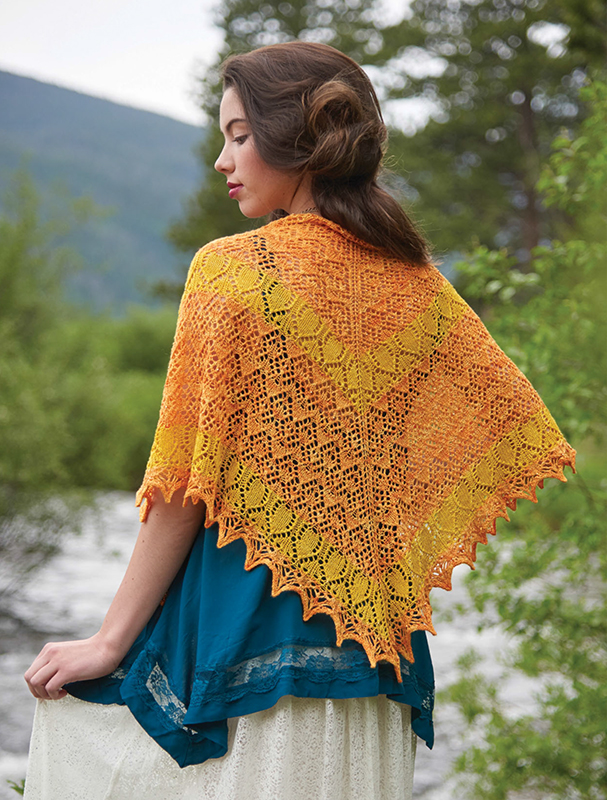
Although experts disagree about exactly how the Caucasus mountain range is shared between Europe and Asia, most agree that Mount Elbrus is the highest mountain on the European continent, at 18,602 feet (5,670 m). The first documented ascent was in 1874. Named after a mountain in Persian mythology, it is a dormant volcano, last active about A.D. 100.
This piece is a triangle with totally interchangeable motifs. You can use chart A, Rows 13–32 and chart B at will, and one will flow from the other any way you choose to use them. You can also make this piece as large as you like, adding extra repeats of chart A, Rows 13–32 and/or chart B, Rows 1–20, limited only by your yarn supply. Chart C will flow from either chart A or chart B. If you enjoy thinking about the triangle in a modular way, try some of the ideas in the final chapter! Directions are given for two versions of this project, but feel free to mix and match the charts.

561⁄2" (143.5 cm) wide and 27" (68.5 cm) long.
Laceweight (#0 Lace).
Shown here: SweetGeorgia Merino Silk Lace (50% merino, 50% silk; 765 yd [700 m]/100 g): Saffron (yellow, A) and Dutch (orange, B), 1 skein each.
Size U.S. 3 (3.25 mm): 40" (100 cm) circular (cir). Adjust needle size if necessary to obtain the correct gauge.
Smooth waste yarn; 30 g Miyuki 8/0 Japanese seed beads in gold/galvanized; size U.S. 14 (0.6 mm) steel crochet hook; markers (optional); tapestry needle; stainless T-pins; blocking mats; one 60" (152.5 cm) length of blocking wire.
20 sts = 4" (10 cm) over St st, blocked and relaxed.
Beads: See Techniques.

A word about slipping selvedge stitches: Don’t! This piece was designed to block freely and slipped selvedge stitches will create a less flexible edge.
Directions are given for Version 1, with Version 2 in parentheses. Version 1 is worked primarily using chart A with color A (Saffron) with highlights in chart B with color B (Dutch). Version 2 is worked primarily using chart B with color B (Dutch) with highlights in chart A with color A (Saffron). The suggested yarn and beads will allow you to make both versions.
After working chart A (B) Rows 13–32 (1–20) for the first time, each additional time you repeat these rows, you will be working the 10-st repeat 2 more times in each half of the shawl.
With color A (B), CO 3 sts using provisional method (see Techniques).
Knit 7 rows.
Next row: K3, do not turn, but rotate piece 90 degrees right, then pick up and purl 3 sts along the left-side edge (1 st in each garter ridge). Turn work another 90 degrees right and pick up and knit 3 sts in provisional CO, removing waste yarn—9 sts.
Turn work.
Row 1: (RS) Beg at right edge of chart A, work Row 1—4 sts inc’d.
Row 2: (WS) Beg at left edge of chart and work Row 2.
Work Rows 3–12 in established patt—33 sts.
Work Rows 13–32 (1–20) of chart A (B) 3 times—153 sts.
With color A for both versions, work Rows 1–10 (13–32) of chart B (A) once—173 (193) sts.
Change to color B. Work Rows 11–20 of chart B once—193 sts.
Change to A (B). Work Rows 13–32 (1–20) of chart A (B) 3 times—313 sts.
Work Rows 1–10 of chart B once—20 sts inc’d.
Change to B. Work Rows 11¬–20 of chart B once—353 sts.
Work Rows 13–32 of chart A once—353 sts.
With A (B), work Rows 1–10 of chart C once—441 sts.
With color A (B), work I-cord BO as foll:
Using knitted CO (see Techniques), CO 2 sts and place sts on left needle tip.
Next row: Pull yarn across back of work, k3, sl 3 sts just worked back to left needle tip.
Next row: Pull yarn across back of work, k2, k2tog, sl 3 sts just worked back to left needle tip.
Rep last 2 rows to last 3 sts.
Next row: K3togtbl. Cut yarn leaving a 9" (23 cm) tail, pull tail through rem st.
Weave in ends but do not trim. Soak in cool water until fully saturated (about 30 minutes). Press to remove water, roll in a towel, and blot to remove extra water.
Weave blocking wire through every vertical strand in garter st along top edge. Pin piece out to schematic measurements, pinning out each point, from inside the I-cord, so columns of sts are straight and even. Allow to dry completely. Shawl will relax to finished measurements after removing pins. Trim ends.


